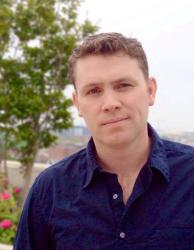When contemporary transhumanists like Yuval Noah Harari speak about future migrations and amalgamations of human consciousness, they generally preface their ideas with outright dismissals of religion and the truths it may offer. In A Cloud of Unknowing, the new book by Andrew Gillsmith, transhumanism, among other topics, is grappled with alongside and in the context of religion’s pervasive truths. Indeed, it is difficult to tell if the novel’s archvillain, a scientist named Ralph Channing, is himself the actual antichrist or just a particularly nasty version of a Harari-like figure. This is no criticism, as the book is actually made the better for the reader’s inability to make a distinction on this point (or on many other philosophical questions). That is to say, Gillsmith’s book is a satisfying read that achieves its goals by, in many ways, not satisfactorily resolving the thorny and deeply complex issues it raises.
A Cloud of Unknowing is a sequel to 2022’s Our Lady of the Artilects, which introduced a future world of neural implants in most human brains and a population of humanoid cyborgs designed to reason and make moral judgments just as humans do. (The first book certainly needs to be read in order to understand the second.) A religious vision shared by all the cyborgs (or “artilects”) and the apparent demonic possession of one of them drives the plot of the first installment. Prison camps in Xinjiang, China, where a holocaust of the country’s Christians had previously occurred, also play an important role in the story.
The newly released sequel likewise focuses on the artilects and their moral status, and it draws the reader even deeper into the mysterious camps. Channing is the common antagonist in both installments, although he is revealed to be far more sinister and far more enduring a threat than the first book had suggested. The other characters, too, are mostly returning ones from Our Lady, including priests, cardinals, imams, soldiers, scientists, and artilects. Most prominently, Fr. Gabriel Serafian, the hero of the initial story, remains at the center of the proceedings in Cloud.
Much of the Serafian character (and the book’s plot) owes a good deal to a real-life person from recent history, one Fr. Malachi Martin. Martin was a one-time academic, a Jesuit priest (and later, a non-Jesuit priest), an exorcist, a confidant of cardinals in Rome, and a keen observer of geopolitics (especially in his nonfiction book The Keys of This Blood, which placed the Catholic Church at the center of an assessment of the struggle for global power in the closing decades of the 20th century). Across multiple hours-long interviews on Art Bell’s overnight conspiracy theory/occult radio program, Coast to Coast AM, in the late 1990s, Martin shared his (sometimes deeply unserious) views on the antichrist, astronomical signs and the Vatican’s observatories, and the Luciferian manipulation of radiation. For his part, the character Serafian is a one-time academic turned Jesuit, an exorcist, and a confidant of a cardinal in Rome. Key plot points in Cloud include the ways in which the Church is trying to maintain its central role as it navigates complex geopolitics, confrontation with a potential antichrist, an intervention by the director of the Vatican Observatory, and mysterious radiation (dubbed “Lucifer particles”) besetting the Earth’s atmosphere. Indeed, Gillsmith hat tips the connection in the most obvious of ways: Martin sometimes wrote under the pen name Serafian.
That said, and thankfully, the book’s priest-protagonist lacks some of the silliness of the man upon whom he is based. (In one installment of Bell’s show, a caller claimed to be a vampire, which Martin accepted as the basis for an extended and nonconfrontational conversation in which the priest stated that he was familiar with the vampire school the caller attended.) Serafian is rather a more sober and reliable guide through the events of Cloud, in which he plays a role in a papal conclave, seeks to further understand and counteract the threat of the Lucifer particles, and tries to prevent the destruction of the artilect population by global leaders who blame them for a dramatic and frightening event that took place at the end of the previous book. Through these efforts, he begins to realize the full importance of the camps at Xinjiang, where he must travel to finally put all the pieces together. It is there, too, that he must make the story’s crucial decision—one that leaves the reader conflicted. To be sure, this new installment is a more challenging read than the preceding one. This is both because it delves deeper into both scientific and philosophical questions about consciousness, belief, and human value in repeated, extended conversations, but also because it is simply a darker and more brutal story.
A Cloud of Unknowing borrows its name from a mystical treatise from the 14th century that focused on the unknowability of God and the manner in which this unknowing allows the faithful to grow closer to Him—an approach that Yuval Noah Harari or Ralph Channing would certainly reject outright. But other characters in Gillsmith’s book struggle mightily with the appropriate extent of knowing, and the positions they take have eternal consequences.
Gabriel Serafian stands firm in his view on the subject, leading him to a stunning act of sacrifice that feels necessary but unheroic even to himself. Sacrifice itself is a major theme in the story, and three separate characters make some version of the statement that “the universe requires sacrifice. It always has, and it always will, because the universe is sacramental.” It’s a statement that was likewise made multiple times in Our Lady of the Artilects, in which its implications were both far less severe and more satisfying. In Cloud, the author seems to be challenging the reader to consider which sacrifices are worthy and who can choose what is sacrificed and when. To this point, it is telling that the book mentions the story of Abraham and Isaac more than once, and that the statement about sacrifice being needed because of the sacramental nature of the universe is made by actors on opposite sides of the moral spectrum.
Of course, those who hold a sacramental worldview acknowledge that the sacraments themselves entail more than sacrifice: they also impart grace. Transformative, sanctifying, and actual graces abound in the world and are appreciated and longed for, by definition, by any person who believes in sacraments at all. One can in fact say that a sacramental universe is defined by grace, by the real working of God using the materials and humans of His creation. It seems likely that there will be a third book in this series (and readers should look forward to it). Perhaps it will have a place for the grace as well as the sacrifice that make the universe sacramental.

